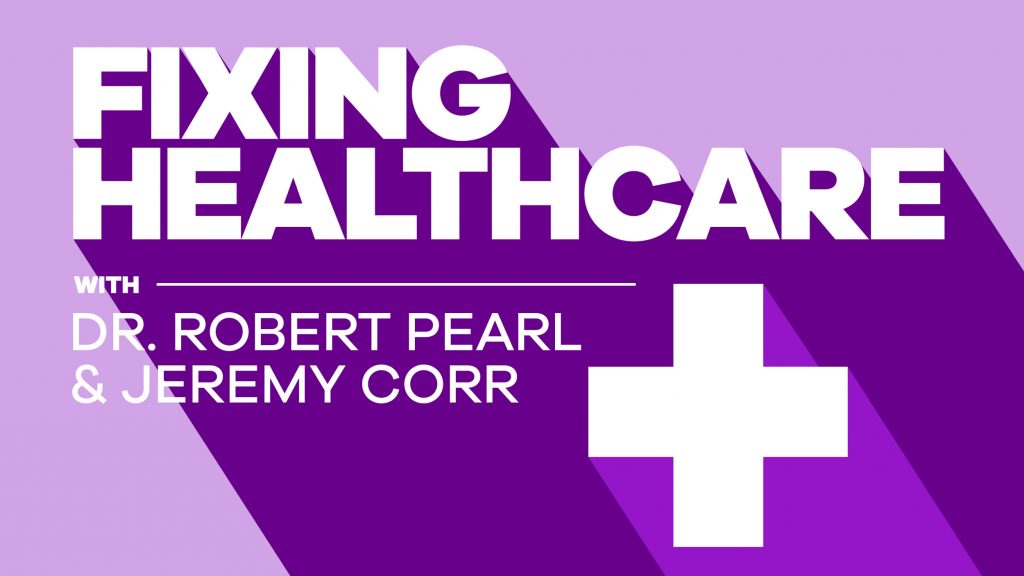Podcast: Play in new window | Download
Subscribe: Spotify | Email | RSS | More
The Fixing Healthcare podcast debuted its first episode by welcoming to the show one of healthcare’s most brilliant and entertaining leaders, Dr. Zubin Damania, MD.
Dr. Damania is known throughout the digital and social media landscape by his moniker ZDoggMD. He’s also an internist, a hospitalist and the founder of Turntable Health, an innovative primary care startup in Las Vegas that earned the backing of Zappos CEO Tony Hsieh. In addition to his clinical accolades, ZDoggMD performs stand-up comedy, “mercilessly satirizing our dysfunctional healthcare system.” He posts viral videos and hosts an online series, which together have amassed a following of 1.7 million patients and providers worldwide.
This week, ZDoggMD became the first-ever applicant for the newly opened position: “Leader of American Healthcare.”
According to co-hosts and “hiring managers” Dr. Robert Pearl and Jeremy Corr, Dr. Damania’s first task: Present the American people with a plan to fix healthcare, not minor tweaks or trade-offs among quality, cost and service.
Here are the top ZDoggMD highlights from the show
1. On how we pay for healthcare vs. what we’re paying for
I think the first thing we need to distinguish if we’re going to address this huge, huge, huge, issue is that there’s this distinction between how to pay for healthcare and what you’re actually paying for. First, we have to fix what you’re actually paying for. So, the first thing we’re going to do is invert healthcare from a sick-care reactive system that puts band aids on problems … to a focus on actual healthcare. And in order to do that, we have to start inverting the problem we have in this country, which is too many specialists, hospitals, and not enough primary-care prevention: OB/GYN, geriatrics, pediatrics, family medicine, internal medicine, etc.
2. On simple steps to improve patient service and convenience
Let’s go where the patients need us: telehealth visits, phone, email, Skype. That’s where our patients want us but instead we’re stuck behind a clunky EHR that looks like it was built in the ‘90s or worse. Also, not everybody needs a doctor. Sometimes a health coach, a licensed clinical social worker, the team—the nurses, the respiratory therapists—those are the people on the front lines. So we need to encourage that teamwork where everybody’s practicing at the top of their training.
3. On restructuring the hospital system
I’m a hospitalist and what I would say is that, for a single hospital, trying to be everything to everyone is very hard. Toyota would never build cars that way because you’d never be able to isolate failure points in a process that’s so chaotic … So, the first thing you do, is you take everything that has been shown to work and apply it as a standard. Then you break hospitals into bits, so that a surgical hospital that does elective procedures very well should optimize towards that. And it should be geographically accessible to a triage or urgent care center that can send patients to those places, maybe even faster than they could get transferred within one single hospital. And then ultimately realizing that 50% of what we do not only doesn’t work but it causes harm. And so (we should) focus our research and implementation efforts on getting rid of that 50% that doesn’t work. You know what works? Washing our hands, weighing maternity pads to see how much blood is actually lost, etc. And it’s going to take a quality-improvement culture that hasn’t really existed.
4. On keeping patients out of trouble
(Turntable Health) was spending more on primary care. Spending three, maybe four times, what insurers spend normally in Las Vegas, you know, $18 per patient per month or something is what United spends on patients for primary care. And they get what they pay for: fragmented, crappy care with lots of specialists. Now, if you had a value network of patients who are a bit empowered, with a little bit of skin in the game, where they have this $2,000 and they’re like ‘I can spend this on a really good primary care doc who will keep me out of trouble, keep me from spending it downstream,’ well, that’s helpful. So (the plan is) having that support structure and the Medicare for all component of it, which is a very high-deductible, catastrophic plan that keeps people from medical bankruptcy.
5. On the ‘moral injury’ that causes physician burnout
There’s a moral injury that occurs to (doctors) when we feel like we have to treat patients differently because of their insurance status. When we have to treat an undocumented immigrant differently for dialysis—they can only get it emergent in the ER—than somebody who has insurance … it creates moral injury and therefore ‘burnout’ in our physicians. And that’s not a sustainable thing. I think the difference, what caused (Turntable Health) to fail, is that we didn’t have that structure. We were a little too early with the model.
READ: Full transcript of our discussion with ZDoggMD
* * *
Fixing Healthcare is a co-production of Dr. Robert Pearl and Jeremy Corr. Subscribe to the show via Apple Podcasts or wherever you find podcasts. Join the conversation or suggest a guest by following the show on Twitter and LinkedIn.

